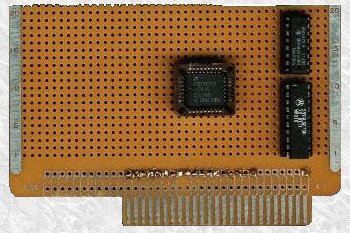

Flash ROM drive project for the Apple II
by RedSkull@digital-corruption.net
Introduction
What is it?
This is a very simple, but flexible design for a Flash ROM
based ROMdrive card to suit an Apple ][,][+,//e.
The circuit is very simple, using only 3 chips and no other
external components.
The software required to interface the card with Dos3.3 is
remarkably simple (full source included) plus I am working
on PRODOS support at the moment.
The Flash ROM chips are programmed in-system, so there is no
need for any expensive complicated programming equipment.
Consequently the design can be used to program Flash Roms for
other purposes outside the Apple // environment.
There are 2 different circuit versions included in this archive:
one for a 28Fxxx version of the card, and another for a 29Fxxx
version.
Different methods are required to program the 28Fxxx and
29Fxxx chips, but as far as reading the chips both circuits
appear identical to the system.
What are the files in this archive?
flashBOT.jpg
flashTOP.jpg
These are pictures of My 29f010 prototype, built on a standard
Radio Shack experimenter board.
FLASHDISK.dsk
FLASHSOURCE.dsk
28fxxx.dsk
These are the disk images (in DOS sector order) that are referred
to in the text. The 28Fxxx.dsk image contains some source code
for programming a 28Fxxx version should you wish to build one.
I recommend using a 29Fxxx series chip, as it is much easier
to program.
README.TXT
READ29F.TXT
Documentation files for the project
ROMD28F.gif
ROMD29F.gif
Circuit diagrams for both the 28Fxxx and 29Fxxx version of the project.

Note: Power connections are not shown to the chips (+5v and GND) but
you are expected to provide them. Refer to the relevent TTL and FLASH
data sheets.
Theory of Operation
The Flash ROM appears to the Apple ][ system as a number of
256 byte blocks that appear at $CN00-$CNFF, where N is the
slot number the card is plugged into. The fact that the
blocks happen to be sector sized simplifies DOS interfacing.
Several registers in the cards I/O space are also used.
(C0N0 space, where N = slot + 8. ie. C0A0-C0AF = slot2 space).
A reference to C0N0 will set the /OE pin on the flash ROM
low, enabling the FlashROM in the CN00-CNFF space. A
reference to C0N1 will set /OE high, disabling the chip
for reading. /OE is set high during programming functions.
If you are using larger FlashRoms then you will have A16,A17
etc. connected.
These addresses are used to set the state of these pins:
C0N2 = A16 low
C0N3 = A16 high
C0N4 = A17 low
C0N5 = A17 high
etc.
A write into the C0Nx space will set the Address lines
A8-A15 on the Flash chip.
For example : (assume a 29F010 card in slot 2)
LDA $C0A2 ; set A16 low on FlashROM.
LDA #$04
STA $C0A0 ; set high order address lines to 04
; plus set /OE low for read.
Addresses $00400 - $004FF in the FlashROM now appear at
$C200-$C2FF in the Apple ][ address space.
After power-on, or after a RESET block 00 automatically
appears in the $CNXX space.
This occurs because the /RESET signal is applied to the 74LS259
and 74LS273 reset inputs, consequently /OE and any of the
high address lines (A16 and up) are set low. Also A8-A15
are set to 0 by the reset on the LS273.
By simulating the ROM from a Disk ][ card in Bank 00 this
ensures that the system will always see the card as a bootable
disk drive card on power-up or Reset.
Programming the chip
Software is provided on the accompanying disk image for:
1. Erasing a previously programmed chip.
2. Programming a Flash chip from main memory
3. Reading the contents of a Flash chip into main memory.
Full source code in BIG MAC format is provided.
The programming routines follow AMD's recommended algorithm,
Intel chips use the same algorithm but I have not tested
any chips other than AMD varieties.
The Algorithms provided are for 28F256 chips (or 28F512
in two seperate blocks).
**** NOTE ****
The 28F256 algorithms contain several self-modifying
instructions. This is not sloppiness in programming on my
part.
Many of you will be familiar with the 6502 nuance that
when a location is written to it is read from first.
This is detailed in the A][ reference manual to explain
why the speaker soft-switch should only be read from,
not written to.
Less well known is that STA NNNN,X and STA NNNN,Y instructions
do a "phantom" read of NNNN before the the correct address
of NNNN,X (or NNNN,Y) is output across the data bus.
During programming of the 28Fxxx chips, this is sufficient
to interfere with the write mode while trying to program
a byte. This particular problem had me stumped for quite
a while until I saw some esoteric docs that explained
this 6502 peculiarity.
**************
Sample code is also included to simulate a disk ][
controller ROM that loads in a DOS 3.3 image.
There is also code for programming the 29Fxxx variety chips
and a DOS3.3 boot image, with instructions in a seperate
doc file.
Summing up
The programming algoritms are pretty obvious, so it should
be easy to adapt them for bigger chips, or to program straight
from large disk files or whatever.
Programming the chips is fairly simple procedure. I recommend
you study the source code if you wish to see how it is
accomplished, or if you want to adapt the design for another
purpose.
I welcome questions of a technical nature, but strongly
discourage questions like "What pin is Q0 on the '259?".
A certain knowledge of Hardware construction and also of
6502 assembly language is assumed in this project.
If you don't feel up to constructing it, DON'T!!